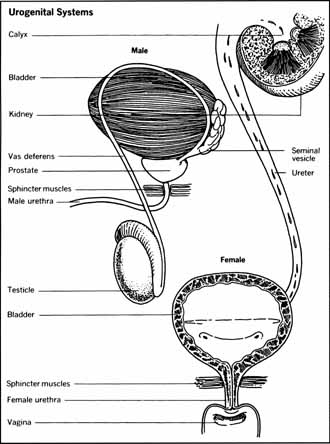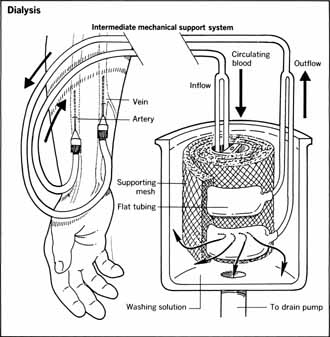Diseases of the Urinogenital System - Kidney failure
Kidney failure can occur gradually—either from kidney disease or as a secondary condition resulting from another disease—or suddenly, as from an infection.
Acute Kidney Failure
The sudden loss of kidney function over a period of minutes to several days is known as acute kidney failure. It may be caused by impairment of blood supply to the kidneys, by severe infection, by nephritis (discussed below), by poisons, and by various other conditions that injure both kidneys.

The body can function adequately throughout a normal life span with only one healthy kidney, but if both are impaired sufficiently over a short period of time, there will be symptoms of acute kidney failure: production of a decreased amount of urine ( oliguria ) sometimes with blood in it; fluid retention in body tissues, a condition known as edema; increasing fatigue and weakness; nausea and loss of appetite.
If damage to the kidneys has not been too severe, the patient begins to have a diuresis , or greater than normal urine output. When this happens—usually after one or two weeks of reduced urine output—he is kept on a restricted diet and reduced fluid intake after recovery until normal kidney function returns.
Causes
Heredity is rarely a factor in acute kidney failure, although people born with one kidney or with congenital defects of the urinary tract may lack the normal reserve capacity to prevent it. It is also unusual for external injury to result in a loss of function in both kidneys. However, severe internal shock accompanied by a reduction of blood flow to the kidneys can cause acute kidney failure.
Prevention and Treatment
Acute kidney failure can occur at any age. Prevention hinges on the proper control of its many causes. About 50 percent of patients with this disease may succumb to it; in cases of severe kidney failure involving widespread destruction of tissue, mortality may be almost 100 percent.
When acute kidney failure occurs as a complication of another serious illness, its prevention and treatment are usually managed by physicians in a hospital. If the patient is not already under a physician's supervision when he has the characteristic symptoms, he should immediately be brought to a medical facility for diagnosis and treatment.
Chronic Kidney Failure and Uremia
Many progressive kidney diseases can eventually lead to a group of symptoms called uremia . Other diseases, such as severe high blood pressure, diabetes, and those leading to widespread damage of kidney tissue, can also cause uremia.
In this condition, as in acute kidney failure, waste products and excess fluid accumulate in the body and cause the symptoms of chronic kidney failure. Certain congenital defects in the urinogenital system such as polycystic kidney disease , in which cysts in the kidneys enlarge slowly and destroy normal kidney tissue, may lead to uremia. Hereditary diseases such as hereditary nephritis may cause chronic kidney failure, but this is uncommon. Injury is also rarely the cause of uremia.
Although kidney failure is more likely to occur in older people because of the decreased capacity of the body to respond to stress, uremia can occur in any age group if kidney damage is severe enough. The onset of uremia may be so gradual that it goes unnoticed until the patient is weak and seems chronically ill. Voiding unusually large amounts of urine and voiding during the night are early symptoms.
Sleepiness and increasing fatigue set in as the kidney failure progresses, and there is a loss of appetite accompanied sometimes by nausea and hiccups. As the disease gets more serious, increasing weakness, anemia, muscle twitching, and sometimes internal bleeding may occur. High blood pressure is another characteristic symptom. Because of fluid retention, there will often be marked signs of facial puffiness and swelling of the legs.
Kidney damage that leads to chronic kidney failure is irreversible, and the outlook for the victim is poor. When the kidneys have become so damaged that they fail to work, there are two treatment options: dialysis and kidney transplantation.
Dialysis
If a transplant is not done, the normal work of the kidneys must be replaced by mechanical means using a procedure called dialysis. There are two types of dialysis, hemodialysis and peritoneal dialysis . Patients also follow a special diet to reduce waste buildup.
Hemodialysis
This procedure cleans and filters the blood, ridding the body of harmful wastes and extra salts and fluids. It controls blood pressure and restores the body's chemical balance. This is done using a filter called a dialyzer —in essence, an artificial kidney. The filter is hooked up to a machine that pumps the patient's blood through the filter. The blood is drawn through one set of tubes connected to the patient and is returned to the body through another set. Patients are awake and can read, write, talk, sleep, or watch television.

Hemodialysis is usually done three times a week and lasts two to four hours per session. It can be done either at a clinic, where nurses or trained technicians perform the procedure, or at home by the patient and a partner. Home hemodialysis is possible with patients who, with the partner, can be relied upon to perform the procedure as required after they have received special training.
Peritoneal Dialysis
This procedure, like hemodialysis, removes extra water, wastes, and chemicals from the body. It uses the lining of the abdomen, called the peritoneal membrane, to filter the blood.
A cleansing solution called dialysate is sent through a tube to the abdomen, where it takes on waste materials that come through the peritoneal membrane. A few hours later, the dialysate is drained away, together with the wastes it contains. The procedure is then repeated. There are three types of peritoneal dialysis, each using a different time frame and different equipment. Depending on the type of peritoneal dialysis used, sessions may take several hours each and take place several times a day; they may be performed overnight during sleep; or they may be done several times a week for up to 24 hours at a time. More information is available from the National Kidney and Urologic Diseases Information Clearinghouse, 3 Information Way, Bethesda, MD 20892-3560; (301) 654-4415.

Comment about this article, ask questions, or add new information about this topic: